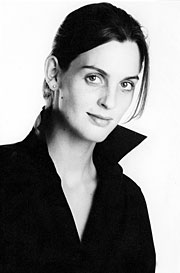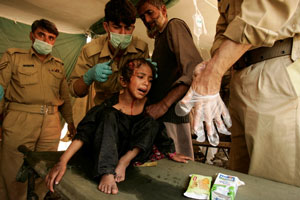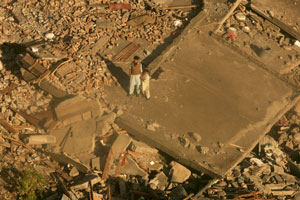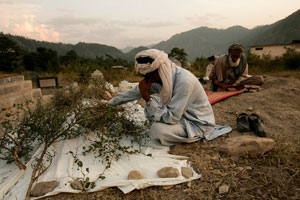 |
 | |||||||||||||
Open Wound
|
 |
||||||||||||
|
When the earth violently shook on Oct. 8 there was no one to hold accountable, just a foreboding sense of helplessness and the hope that media coverage would lead to greater international aid. I have never been one to rush off to natural disasters, but having previously lived in Pakistan for two-and-half years, I felt a real obligation to be there. I hoped my photographs for The New York Times would help Pakistan's people.
Navigating through what seemed like the aftermath of Armageddon, I was constantly struck by the sheer scale of loss. In an instant people's homes and communities were gone, their limbs and lives lost, their loved ones had perished and the survivors had become beggars and orphans.
People occasionally yelled out abuse, incensed by the press intruding into their grief. "Take your shot and piss off," one man yelled as I photographed a woman crying near a school where her child had either been buried alive or instantly killed. Other Kashmiris, having had little interaction with the outside world, followed me out of curiosity, trying to help in any way they could.
Later that day I tried to make my way to Balakot. Bewildered people streamed down the road by the hundreds in search of food and medical aid as a perverted rainbow appeared in the sky.
That night we were awoken by a strong tremor. Everyone rushed outside in the fear the building would collapse. The first week after the initial earthquake there were as many as 2,000 aftershocks. The tremors were so frequent that it was sometimes difficult to know when the earth was still.
The following day I took my first helicopter into Kashmir. The magnitude and scale of the devastation hit me harder when looking at the catastrophe from a bird's-eye view. The people looked so small standing in the debris, desperate for help.
On Oct. 13, five days after the earthquake, I found myself in a field hospital in Balakot photographing Zainab, a five-year-old little girl, receiving medical care without anesthetic. Her head wounds had become infected and the military doctors had no choice but to cut into her scalp and clean the wound. Three children were having the same procedure done at the same time. One child was singing to herself, while another screamed and the other whimpered. At the time I didn't notice that Zainab had wet herself while trying to endure the pain.
A doctor pulled me aside to show me the work he had done on one of the other children, pulling back a flap of flesh from eye level to the middle of the scalp on the child. I turned away, unable to look.
I retreated to a tent filled with supplies, trying to collect my thoughts and digest what I had seen. One of the doctors who had worked on Zainab, Dr. Bilal, came into the tent, desperate to talk. Dr. Bilal had been one of the first four doctors to arrive in Balakot. The injured had flocked to him like hornets to their nest and he had to choose whom to attend first.
That night I cried as I looked at my pictures on my computer screen, reliving the hellish scene.
The seared tuna I ordered as I transmitted was left on the plate untouched. Having seen so many open flesh wounds, the sight of the tuna made me ill. I had barely eaten for four days and yet even with a gourmet meal in front of me I had no appetite.
The earthquake took place during the holy month of Ramadan. Fasting is meant to be a reminder of those who are suffering and have nothing. In the aftermath of the earthquake human suffering was inescapable; even then, many people who were entitled to break fast observed the tradition with a stoic sense of solidarity.
The following morning my agent called to tell me Zainab had made the front page of The New York Times. Zainab is a hero, as are all children who have endured this tragic event.
Knowing that every politician and person of influence in the United States of America saw Zainab's pained face that morning, I felt I had done my job as a photojournalist.
© Kate Brooks
Dispatches are brought to you by Canon. Send Canon a message of thanks. |
|||||||||||||
Back to November 2005 Contents
|
|




